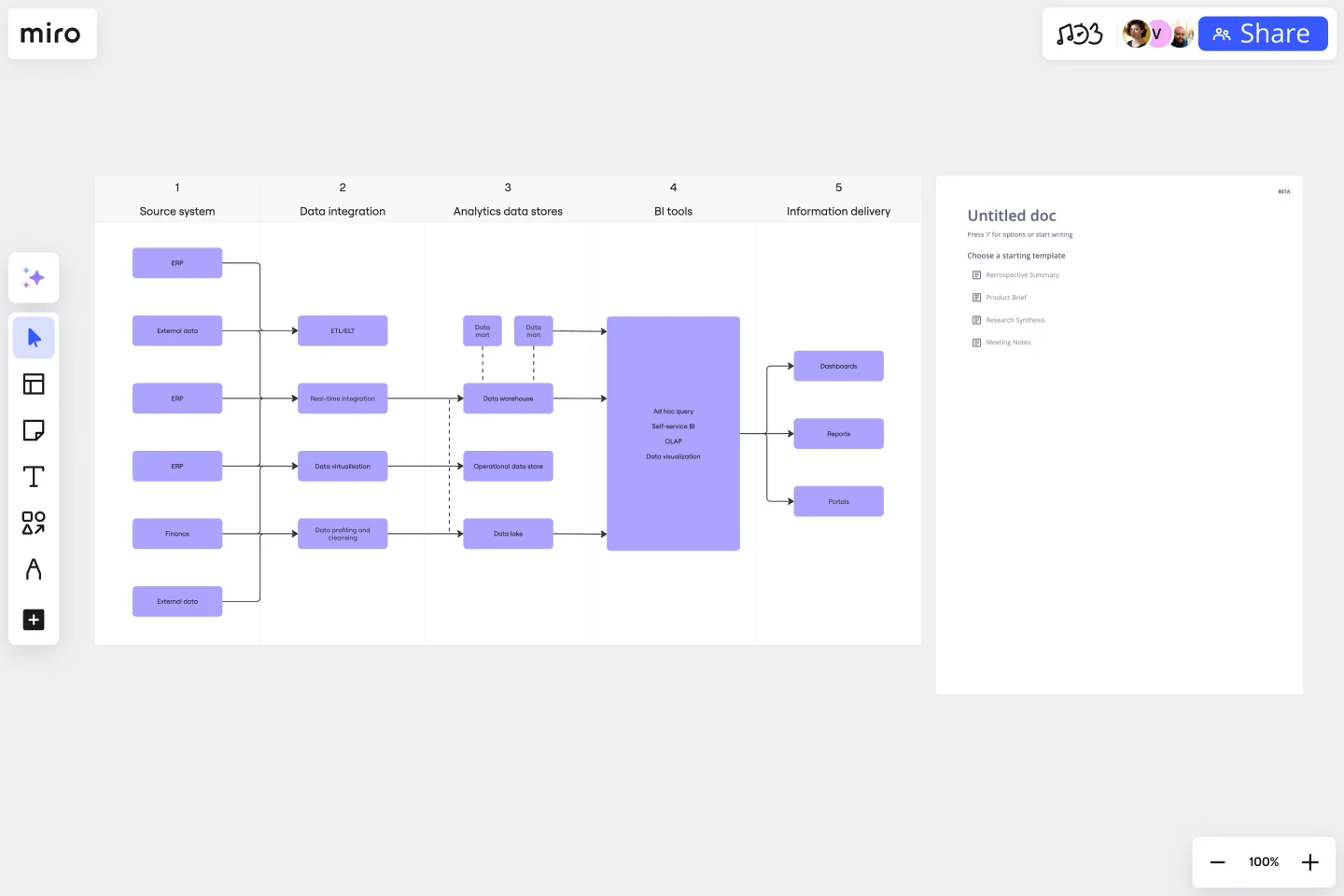Business Intelligence Architecture Template
Simplify complex data structures with the business intelligence architecture template. Visualize data sources, warehouses, ETL processes, tools, and interfaces with ease.
About the Business Intelligence Architecture Template
The Business Intelligence Architecture Diagram Template is a useful tool for creating visual representations of complex data structures and processes in a business intelligence system. This template is designed to meet the needs of IT professionals, data analysts, and business strategists, allowing them to communicate complex ideas effectively and promote better collaboration among team members.
Understanding the template
The business intelligence architecture template is usually divided into key areas, with the role of each component explained.
Data sources: This refers to the various databases and external APIs that contribute to the business intelligence system, providing different data inputs for analysis.
Data warehouse: It is the centralized repository where data is stored and organized in a structured format for easier retrieval and analysis.
ETL process: This process involves three main phases - extraction, transformation, and loading - to convert raw data into a usable format that can be analyzed and stored in the data warehouse.
Business intelligence tools: These are software and tools that help with data analysis, reporting, and visualization, providing a comprehensive view of the technological landscape.
Reporting and dashboards: This refers to the end-user interface, which includes reports and dashboards that offer a clear and user-friendly overview of the analyzed data.
How to use the business intelligence architecture template in Miro
Customize the template easily by using the drag-and-drop feature. This will help you represent your specific architecture seamlessly and with precision.
Miro's automated diagramming feature allows you to expand the template dynamically. This ensures that your diagram stays current with minimal manual intervention.
You can enhance the depth of your diagram by integrating relevant artifacts such as notes, comments, or links onto the Miro board. This provides additional context for your team.
Why should you use a business intelligence architecture Template?
Simplify complex concepts to enhance understanding and communication within the team. Encourage efficient collaboration among team members.
Collaboration is made easier with a visual roadmap, which helps prevent misunderstandings and facilitates decision-making, saving time.
Save time on project planning with professional diagrams.
Miro's automated diagramming features help businesses adapt effortlessly to evolving intelligence landscapes.
Can I customize the colors and shapes in the template?
The template is entirely customizable. Users can change colors, shapes, and labels to align with their preferences and organizational standards.
How frequently should I update my business intelligence architecture diagram?
Regular updates are advisable, particularly when changes occur in data sources, tools, or processes, ensuring the diagram accurately reflects the current state of the business intelligence system.
Get started with this template right now.
Strategic Group Mapping Template
Works best for:
Mapping, Strategy
The Strategic Group Mapping Template is a cutting-edge visual tool designed to translate the competitive landscape of their industry. By allowing users to plot entities based on distinct criteria, this template provides an at-a-glance view of market dynamics. One standout benefit of using this tool is its ability to identify clusters of competitors and market gaps, paving the way for businesses to strategically position themselves for optimal success.
Journey Map To Plot the Customer Experience
Works best for:
Customer Journey Map
A journey is a tool to map out the customer experience of (a part of) your product/service in a visual way.
Fault Tree Analysis Template
Works best for:
Diagramming
The Fault Tree Analysis Template visually breaks down potential system malfunctions, highlighting complex causal relationships between faults. One of its standout benefits is its ability to enhance clarity in complex scenarios, allowing professionals to swiftly pinpoint root causes and prioritize interventions, ensuring a more streamlined approach to problem-solving.
ICOR® Workflows
Works best for:
Flowcharts, Diagrams, Mapping
The ICOR® Workflows template offers a visual framework for documenting and optimizing business processes according to the ICOR® (Input, Control, Output, Resources) methodology. It provides elements for defining process inputs, controls, outputs, and resource requirements. This template enables organizations to streamline operations, enhance quality management, and achieve process excellence. By promoting systematic process documentation and analysis, the ICOR® Workflows template empowers organizations to optimize efficiency, minimize risks, and deliver value to stakeholders effectively.
UML Sequence Deployment Pipeline Template
Works best for:
UML
The UML Sequence Deployment Pipeline Template in Miro visually maps the sequence of steps in an automated deployment pipeline, helping teams in software development and deployment. It helps identify bottlenecks, standardizes the deployment process, and facilitates new member onboarding for continuous improvement.
5-Set Venn Diagram
Works best for:
Venn Diagram
Analyze complex data with the 5 Set Venn Diagram template. This tool allows you to compare and contrast five different sets of data, highlighting intersections and unique elements. Perfect for in-depth data analysis, research, and strategic planning. Ideal for analysts, researchers, and educators looking to present comprehensive data insights in a clear and visual manner.
